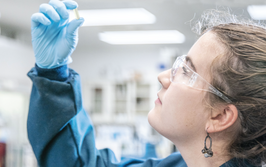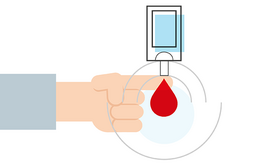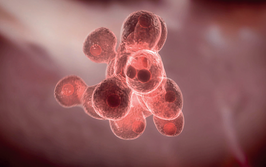The Argument for Albumin
Products are becoming increasingly complex and we need to get better at recognizing the strategies with the best advantages.
Increasingly, the industry is seeing a move away from proteins and peptides towards even more complex drugs, such as antibody drug conjugates, new viral vaccines and cell-based therapies. Of course, such therapies come hand in hand with greater formulation challenges – and in many cases standard formulation technologies are no longer up to scratch. For example, lipids present in vaccine and cell-based therapies can be broken up by standard excipient approaches, while products that require high concentrations, such as antibodies, can be limited by viscosity issues. The incidence of multiple problems, such as aggregation and oxidation occurring simultaneously, is also common in more advanced biopharma products.
In my view, the use of albumin is very effective in formulating complicated products. The stabilization properties of human-serum derived albumin were once well recognized in the industry, but with issues such as Creutzfeldt-Jakob disease and AIDS, serum-derived albumin use declined due to the potential risks. Today, with the availability of recombinant albumin, these risks are eliminated. However, as the industry has moved away from the use of albumin (instead using sugars, amino acids and detergents), many in industry have forgotten the benefits that albumin can bring. It is time to reacquainte the industry with the benefits of albumin. There really is so much to explore that companies are perhaps unaware of, particularly when it comes to early development.
Human albumin is the most abundant protein in plasma and is responsible for the maintenance of oncotic pressure, plasma pH, and the distribution of a variety of endogenous and exogenous ligands. It contains 17 disulphide bonds that provide excellent stability and resilience to environmental stress, and the large number of different binding sites mean that it can interact with a range of products to stabilize them in a variety of situations. It has also been shown that albumin can protect challenging drug, cell and vaccine products from aggregation, non-specific adsorption and oxidation, as well as improve solubility, batch-to-batch consistency, and contribute to low immunogenicity (1)(2)(3)(4)(5)(6)(7).
Albumin provides a relatively simple solution to traditional formulation strategies that require multiple stabilizers. Traditional excipient strategies are cheap, simple compounds that do not interfere with the analysis of the product itself. However, a significant amount of time and effort can be required to optimize the levels, types and combinations of excipients, particularly for the more complex molecules such as antibody-drug conjugates (ADCs) and cell therapies. As you might expect, a good recombinant albumin product that has very high purity and consistency does come with a higher price-tag, which can be a deterrent. While cost is obviously an important element in the decisionmaking process, I would urge drug developers to consider the long-term benefits For example, use of a recombinant albumin can reduce costs down the line by increasing safety and, as part of processing, tends to give higher yields and lower batch-to-batch variability, providing smoother and quicker development. If albumin is used early in the development cycle, it can quickly solve stability issues that would previously have delayed product launch.
However, It is worth considering that the use of albumin will also add complexity to the analytical system, especially for protein products where separation of the drug and albumin to assess stability criteria is more difficult. Using new methods such as AF4 detection and a precolumn to capture albumin prior to the main analytical column can solve these issues. In fact, there are many studies that have shown the advantages that albumin provides for challenging peptide and protein formulations. This complexity is less so for peptides, where separation of the drug and albumin is relatively simple by high-performance liquid chromatography, cell therapies, where the cell function is examined during stability trials (albumin should not interfere here), and vaccines. In Factor VIII products, albumin has been proven to prevent adsorption and also aggregation during lyophilization; and for vaccine products, the inclusion of recombinant human albumin can improve stability in both liquid and solid state, as well as improving yields during harvesting and processing viruses for vaccine preparation (8)(9)(10)(11)(12). Although albumin has fallen out of favor with many drug manufacturers, it is used in Merck Sharp & Dohme’s M-M-R II vaccine and the ProQuad Varicella virus vaccine – and has also been used to improve existing drugs, such as the chemotherapy drug Paclitaxel. Paclitaxel was previously formulated in solvents and other aggressive compounds, which resulted in adverse clinical events. The drug has since been reformulated using albumin and is marketed as Abraxane.
There may be occasions where is it not necessary to use albumin. For example, if you are working with an API that is very stable and can be easily formulated, then a traditional formulation strategy is likely to suffice. However, in many instances, recombinant albumin can be used to further improve stability and may open up opportunities for product differentiation, such as being able to use the drug with a pen syringe.
Drug development and formulation is becoming increasingly difficult and we need to use all of the tools at our disposal to get the best drugs to market. Albumin is a cost effective, single solution to a large number of stability issues, and is particularly effective when used in very early development – products can be stabilized quickly in a common formulation, speeding up the long route to market.
- T Peters Jr, All About Albumin, Biochemistry, Genetics, and Medical Applications, Academic Press (1995).
- M Otagiri, VT Giam Chuang (Eds), Albumin in Medicine Pathological and Clinical Applications, Springer Singapore (2016).
- A Hawe, W Friess, “Stabilization of a hydrophobic recombinant cytokine by human serum albumin,” J. Pharm. Sci., 96, 2987-2999 (2007).
- TE Finn et al., “Serum albumin prevents protein aggregation and amyloid formation and retains chaperone-like activity in the presence of physiological ligands,” J. Biol. Chem., 15;287, 21530-21540 (2012).
- W Wang, “Instability, stabilization, and formulation of liquid protein pharmaceuticals,” Int. J. Pharm., 185, 129–188 (1999)
- E Tarelli et al., “Recombinant human albumin as a stabilizer for biological materials and for the preparation of international reference reagents,” Biologicals, 26, 331-346 (1998).
- TJ Kamerzell et al., “Protein–excipient interactions: Mechanisms and biophysical characterization applied to protein formulation development,” Advanced Drug Delivery Reviews, 63, 1118–1159 (2011).
- R Pearlman, YJ Wang (Eds), Formulation, Characterization, and Stability of Protein Drugs. Case Histories, Springer US (2002).
- JA White et al., “Development of a stable liquid formulation of live attenuated influenza vaccine,” Vaccine 12;34, 3676-3683 (2016).
- RE Spier, “Perception of risk of vaccine adverse events: a historical perspective,” Vaccine 15;20 s78-s4 (2001).
- W Sun, KL Roland, R Curtiss III, “Developing live vaccines against Yersinia pestis.” J. Infect. Dev. Ctries., 5, 614-627 (2011).
- RT Wiedmann et al., “M-M-R(®)II manufactured using recombinant human albumin (rHA) and M-M-R(®)II manufactured using human serum albumin (HSA) exhibit similar safety and immunogenicity profiles when administered as a 2-dose regimen to healthy children,” 33, 2132-2140 (2015).
Phil Morton is Chief Technology Officer at Albumedix.


















